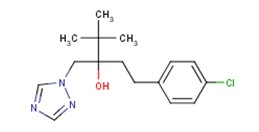Tebuconazole
Inquiry
| Post Date: | Nov 04,2013 | ||
| Expiry Date: | May 03,2014 | ||
| Detailed Description: |
Cas No. :107534-96-3
|
| CAS Registry Number: | 107534-96-3 |
| Synonyms: | ;1,2,4-Triazole-1-ethanol, alpha-(2-(4-chlorophenyl)ethyl)-alpha-(1,1-dimethylethyl)-, (+-),;alpha-(2-(4-chlorophenyl)ethyl)-alpha-(1,1-dimethylethyl)-1H-1,2,4-triazol-1-ethanol, (+-)-;Elite;Folicur;Folicur 1.2 EC;GWG 1609;HWG 1608;Lynx;LYNX 1.2;Raxil;1-(4-chlorphenyl)-4,4-dimethyl-3-(1H-1,2,4-triazole-1-methyl)amyl-3-alcohol;Horizon;(RS)-1-(4-chlorophenyl)-4,4-dimethyl-3-(,2,4-triazol-1-yl)-1-3-ol;(RS)-1-p-chlorophenyl-4,4-dimethyl-3-(1H-1,2,4-triazol-1-ylmethyl)pentan-3-ol;Tebuconazol;1-(4-Chlorophenyl)-4,4-dimethyl-3-(1,2,4-triazole-1-yl-methyl)pentane-3-ol;Lynx Raxil;Silvacur;(RS)-1 -(4-chlorophenyl)-4,4-dimethyl-3-(1H-1,2,4-triazol-l-ylmethyl)pentan-3-ol;(+/-)-alpha-(2-(4-chlorophenyl)ethyl)-alpha-(1,1-dimethylethyl)-1H-1,2,4-triazol-1-ethanol;1-(4-chlorophenyl)-4,4-dimethyl-3-(1H-1,2,4-triazol-1-ylmethyl)pentan-3-ol;2-[2-(4-chlorophenyl)ethyl]-3,3-dimethyl-2-(1H-1,2,4-triazol-1-yl)butan-1-ol; |
| Molecular Formula: | C16H22ClN3O |
| Molecular Weight: | 307.8184 |
| Molecular Structure: | 
|
| Hazard Symbols: |  Xn:Harmful; Xn:Harmful; N:Dangerous for the environment; N:Dangerous for the environment; |
| Risk Codes: | R22:; R51/53:; R63:; |
| Safety Description: | S2:; S22:; S36/37:; S61:; |
| Company: | Nanjing Essence Fine-chemical Co., Ltd [ China ] |
| Contact: | Valerie Zhou |
| Tel: | 025-86518999-836 |
| Fax: | 025 -86455985 |
| Email: | sales@essencechem.com |
-
Disclaimer statement:The information and data included above have been realized by the enterprises and compiled by the staff, and are subject to change without notice to you. The Chemnet makes no warranties or representations whatsoever regarding the facticity, accuracy and validity of such information and data. In order to ensure your interest, we suggest you chose the products posted by our gold suppliers or VIP members.

 CAS No.: 107534-96-3
CAS No.: 107534-96-3
